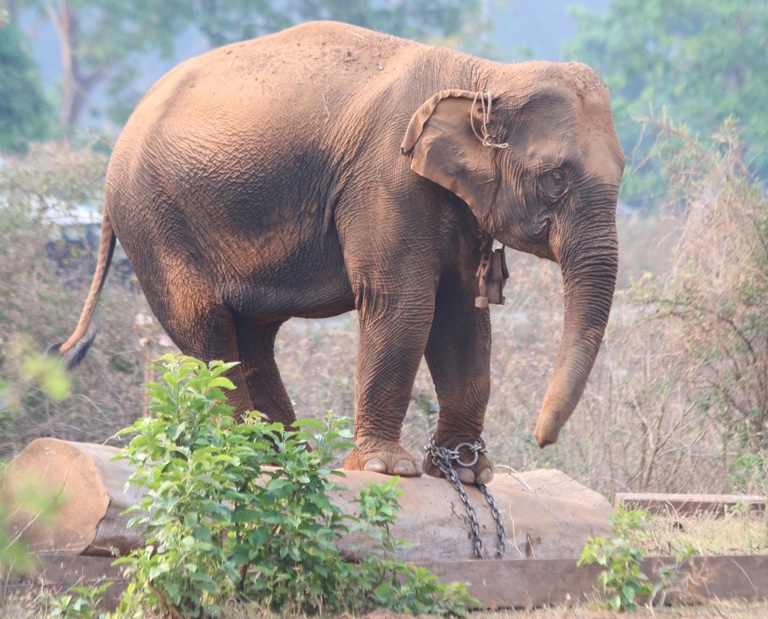- Myanmar’s wild-caught timber elephants have higher rates of mortality and shorter life spans compared to those born in captivity, a new study has found.
- Among wild-caught individuals, elephants that were captured at older ages were worse off than those caught at younger ages, the researchers found.
- Wild-caught elephants also suffered the highest mortality rates during the first year after capture, which decreased slowly over subsequent years.
- The high number of deaths in the year following capture is likely related to capture-related injuries and trauma, followed by harsh taming, the authors say.
In Myanmar, more than 5,000 elephants have been put to work in the logging industry over the past century, accounting for one of the world’s largest captive elephant populations. They include elephants caught from the wild and tamed, as well as elephants born in captivity.
Both the wild-caught and captive-born elephants live, eat and work together, hauling logs by day and foraging in the forest by night. They are also subject to the same rules, including those governing workload, rest periods, retirement age and data recording.
But there’s a key difference: Myanmar’s wild-caught timber elephants have higher rates of mortality and shorter life spans than those born in captivity, according to a new study published in Nature Communications.

For more than a century, the government of Myanmar (formerly Burma) has maintained detailed records of Asian elephants (Elephas maximus) employed in the timber industry, such as when an elephant was born, whether in the wild or in captivity; its age when it was tamed; and who its parents and offspring are. If the elephant was captured, then the records detailed how it was caught: whether it was part of a herd that had been driven into a stockade, whether it was immobilized by sedation or captured by lasso.
By combing through this dataset of 5,150 timber elephants — of which 2,072 were captured from the wild between 1951 and 2000, and 3,078 were born in captivity between 1925 and 1999 — researchers found that wild-caught elephants had higher mortality rates than captive-born elephants at all ages, irrespective of how they were caught.
“Our analysis reveals that wild-captured elephants had lower survival chances than captive-born elephants regardless of how they’d been captured, whether by stockade of whole groups, lassoing single elephants, or immobilisation by sedation,” lead author Mirkka Lahdenpera, a postdoctoral research fellow at the University of Turku, Finland, said in a statement. “This means that all these methods had an equally negative effect on the elephant’s subsequent life.”
In fact, capture seemed to reduce the median life span of elephants by up to seven years compared to their captive-born peers. Among the wild-caught individuals, elephants that were captured at older ages were worse off than those caught at younger ages.
The team also found that wild-caught elephants suffered the highest mortality rates during the first year after capture. This decreased slowly over subsequent years. Such a high number of deaths in the year following capture is likely related to capture-related injuries and trauma, followed by harsh taming, the authors say.
For instance, captured elephants in Myanmar are “first broken and then trained to walk with hobbles to restrict their movement while night foraging,” the authors write, “and the older the elephants at capture, the more difficult it is to move around with hobbles (to which captive-born individuals are used to after their taming around age 5), which is also likely to restrict their nutritional intake.”
This capture and training likely induces chronic stress in captured elephants, they add. However, there are currently no studies that directly compare stress in wild-captured and captive-born elephants kept in similar systems.
The Myanmar government banned the wild capture of elephants in 1994. But the pachyderms continue to be captured throughout Southeast and South Asia to sustain populations in zoos, and for research and conservation programs.
“The long-term overall cost of capture and taming resulted in a median lifespan that is 3-7 years shorter than that of captive-born elephants,” said Virpi Lummaa, the study’s senior investigator and an academy professor at the University of Turku. “Capturing elephants to sustain captive populations is, consequently, detrimental, because it not just reduces wild populations of this endangered species, but it also cannot provide a viable solution to sustain captive populations. These wild-caught animals live shorter lives and reproduce poorly in captivity.”

Citation:
Lahdenperä, M., Mar, K. U., Courtiol, A., & Lummaa, V. (2018). Differences in age-specific mortality between wild-caught and captive-born Asian elephants. Nature communications, 9(1), 3023.
Banner image of Asian elephant by Rhett A. Butler/Mongabay.
